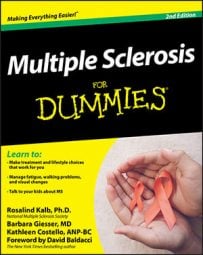Because stress management in multiple sclerosis (MS) isn’t a one-size-fits-all proposition, the menu of techniques is extensive. Some of the basic types are out lined here, but you can check out Stress Management For Dummies by Allen Elkin (John Wiley & Sons, Inc.) for all the details on how to apply these strategies and others to the wide variety of stresses (MS-related and not) in your life.
The key is figuring out what works best for you and sticking with it. But, be ready to tweak the technique if your needs change. Here are the basics:
Exercise is a known stress reliever, and believe it or not, with all the different kinds of exercise out there you’re sure to find something you enjoy — team sports, aerobics, weight machines, t’ai chi, yoga, swimming, cycling, and the list goes on and on.
The National MS Society can refer you to Society-sponsored exercise programs in your area (800-FIGHT-MS) or to a physical therapist who can design an exercise regimen that meets your specific needs and limitations.
Relaxation strategies don’t burn up a lot of calories, but they’re great for relieving stress. You may need to try a few before you find the one that works best for you. Keep in mind that learning to relax takes practice, so it generally takes a month or so to really get the benefits. Here are some strategies you can try:
Deep breathing exercises: The great thing about deep breathing is that it can be done anywhere, any time. We recommend that you start and end your day with some relaxed, comfortable deep breathing. Also, spend a few extra minutes breathing deeply any time you’re feeling particularly stressed out.
Visualization: This exercise involves clearing your mind of everything except for the one scene you want to focus on. Pick a scene that’s filled with pleasurable stimuli — your favorite beach, a beautiful park, mountains covered with snow — and enjoy your “visit.” You need to be able carve out several minutes in a quiet place for this relaxation exercise to work properly.
When practicing visualization, we suggest starting with a few cycles of deep breathing. Then spend five to ten minutes experiencing as many details of your scene as you possibly can — the sights, sounds, smells, and anything else that your imagination can conjure up.
Meditation: For those of you who find visualization to be a piece of cake, meditation is the next step. The goal of meditation is to concentrate on a particular word, phrase, or sound (called a mantra) that you repeat silently or aloud over and over again. To meditate properly, you need a good 15 to 20 minutes a couple of times a day (preferably on a consistent schedule).
With practice, you can use the focused repetition of meditation to block out other thoughts, sights, and sounds. The word or sound you choose to repeat doesn’t matter as long as it’s something soothing and comforting. Being able to remain focused for more than a couple of minutes takes quite a bit of practice, but the payoff is a real sense of calm.
Progressive muscle relaxation: Relaxing each of your 17 muscle groups in sequence is a great way to get your whole body into a comfortable and relaxed state. You can do this exercise sitting in a chair or lying on your bed. Either way, the process involves tensing and relaxing individual parts of your body and taking the time to notice how the changes feel.
You can start from the top and work your way down or you can start from your fingers and toes and move inward toward the center of your body. Whatever you do, don’t forget the small parts, such as your eyes, tongue, and jaw. Progressive relaxation makes for a relaxing start to the day and a peaceful way to prepare your body for sleep.
If you have significant spasticity (stiffness) in certain muscles, tensing them may cause a spasm. Ask your neurologist or physical therapist for recommendations on how to best exercise those muscle groups.
Developing effective stress management techniques takes time, practice, and patience. If you find it difficult to get into any of the techniques, or if you continue to feel stressed out in spite of your best efforts, you may want to consult an expert.
The National MS Society (800-FIGHT-MS or 800-344-4867) can refer you to a mental health professional (such as a psychologist, social worker, or counselor) in your area who can help you find ways to manage your stresses more comfortably. Also, check out the National MS Society booklet, Taming Stress in MS for detailed instructions.

